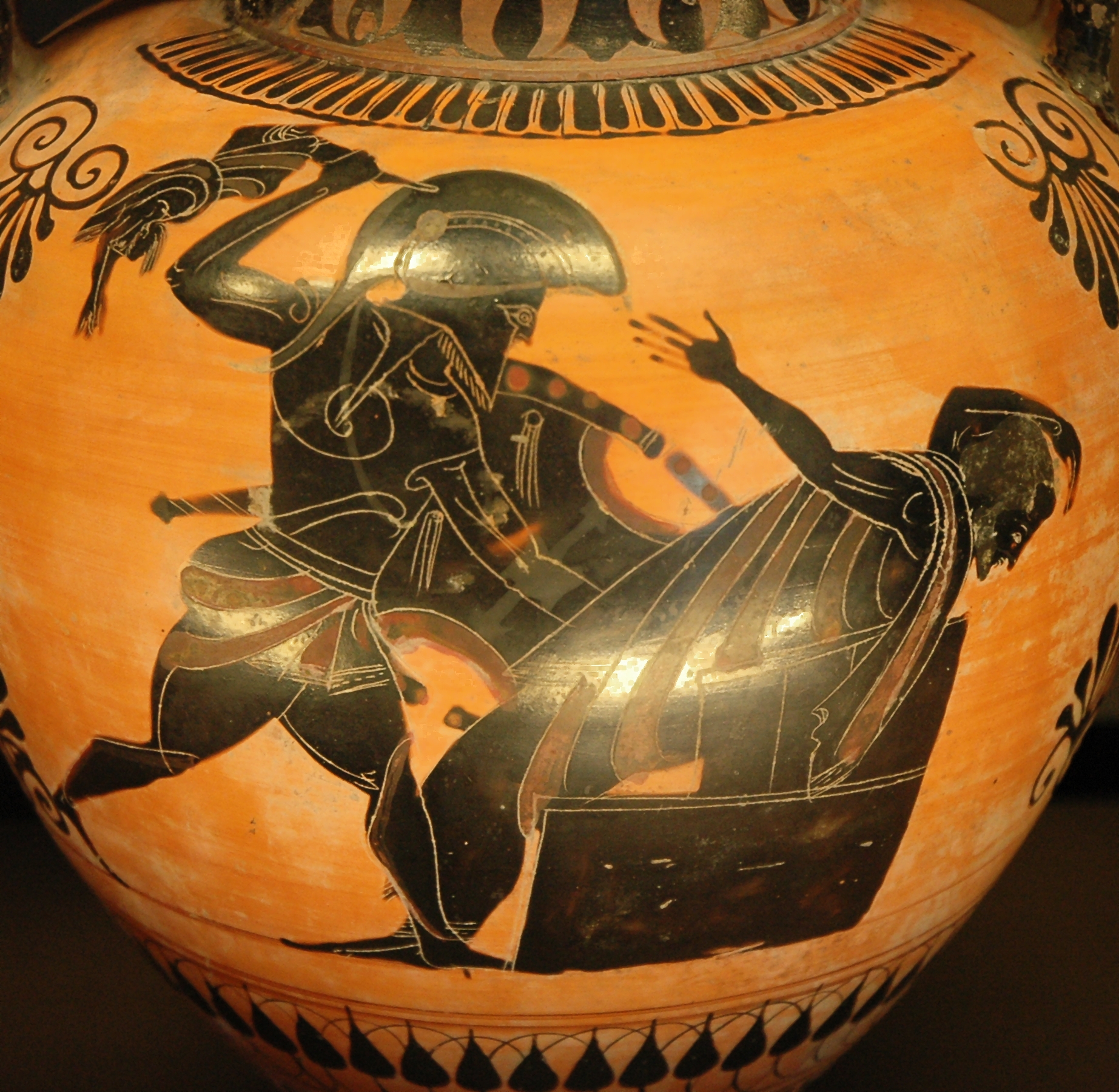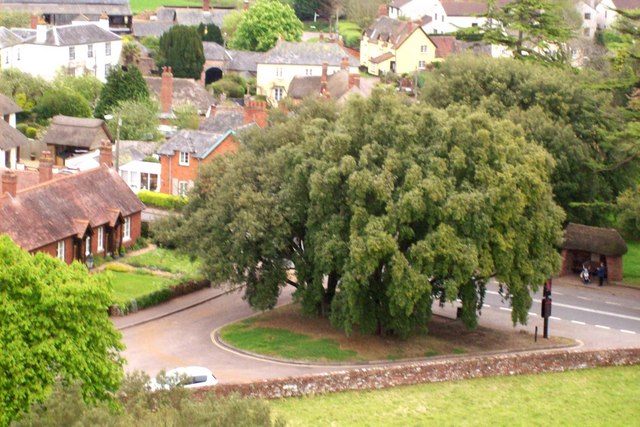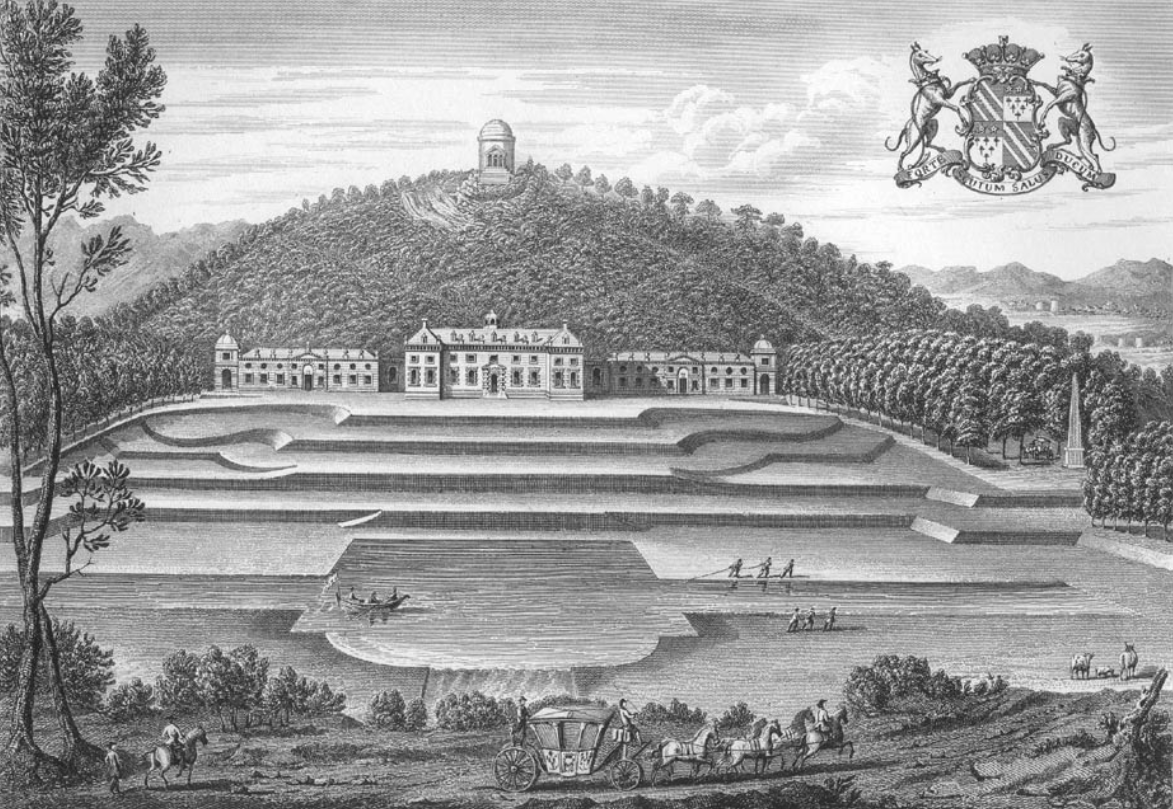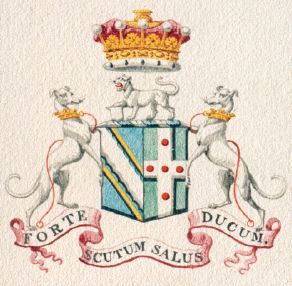|
Sir Thomas Acland, 9th Baronet
Sir Thomas Dyke Acland, 9th Baronet (18 April 1752 – 17 May 1794) of Killerton in Devon and Holnicote in Somerset, was a prominent landowner and member of the West Country gentry. He was especially noted for his passion for staghunting, in which respect he took after his father. Like his father he was known locally in Devon and Somerset as "Sir Thomas his Honour". Origins He was the second son of Sir Thomas Dyke Acland, 7th Baronet (1722–1785) of Killerton in Devon and Petherton Park in Somerset, by his wife Elizabeth Dyke (died 1753), daughter and heiress of Thomas Dyke of Tetton, Holnicote and Pixton in Somerset. The ancient Acland family, believed to be of Flemish origin, originated at the estate of Acland in the parish of Landkey in North Devon, where it is first recorded in 1155. Succession He succeeded his seven-year-old nephew Sir John Dyke Acland, 8th Baronet (1778–1785) as 9th Baronet on the latter's death in April 1785. According to tradition he had bec ... [...More Info...] [...Related Items...] OR: [Wikipedia] [Google] [Baidu] |
John Dyke Acland
Colonel John Dyke Acland (18 February 1746 – 31 October 1778), of Tetton and Pixton in Somerset, was Tory Member of Parliament for Callington in Cornwall and fought in the American War of Independence in 1776.Chambers Biographical Dictionary, , page 6 Origins He was the eldest son and heir apparent of Sir Thomas Dyke Acland, 7th Baronet (1722-1785) of Killerton in Devon and Petherton Park in Somerset, by his wife Elizabeth Dyke (d.1753), daughter and heiress of Thomas Dyke of Tetton, Holnicote and Pixton in Somerset. The ancient Acland family, believed to be of Flemish origin, originated at the estate of Acland in the parish of Landkey in North Devon, where it is first recorded in 1155. Career Acland was Colonel of the 1st Devon Militia,Vivian, p. 5 formed to protect Great Britain from a feared French invasion. In 1774 he was elected Member of Parliament for the rotten borough of Callington in Cornwall, and forcefully expressed his Tory views in parliament by virulentl ... [...More Info...] [...Related Items...] OR: [Wikipedia] [Google] [Baidu] |
Priam
In Greek mythology, Priam (; grc-gre, Πρίαμος, ) was the legendary and last king of Troy during the Trojan War. He was the son of Laomedon. His many children included notable characters such as Hector, Paris, and Cassandra. Etymology Most scholars take the etymology of the name from the Luwian 𒉺𒊑𒀀𒈬𒀀 (Pa-ri-a-mu-a-, or “exceptionally courageous”), attested as the name of a man from Zazlippa, in Kizzuwatna. A similar form is attested transcribed in Greek as ''Paramoas'' near Kaisareia in Cappadocia. Some have identified Priam with the historical figure of Piyama-Radu, a warlord active in the vicinity of Wilusa. However, this identification is disputed, and is highly unlikely, given that he was known in Hittite records as being an ally of the Ahhiyawa against Wilusa. A popular folk etymology derives the name from the Greek verb , meaning 'to buy'. This in turn gives rise to a story of Priam's sister Hesione ransoming his freedom, with a golden veil that A ... [...More Info...] [...Related Items...] OR: [Wikipedia] [Google] [Baidu] |
Broadclyst
Broadclyst is a village and civil parish in the East Devon local government district. It lies approximately 5 miles northeast of the city of Exeter, Devon, England, on the B3181. In 2001 its population was 2,830, reducing at the 2011 Census to 1,467. An electoral ward with the same name exists whose population at the above census was 4,842. Parish church Its church is 15th century, with an ancient cross. It has many battlements, pinnacles and gargoyles. According to the Anglo-Saxon Chronicle, in the year 1001, the manor at Broad Clyst was burned down by Danish invaders. Communications On 16 October 1975, the nearby M5 opened and the A38 road that ran through the village became quiet, later being reclassified B3181. Broadclyst railway station was opened in 1860 by the London and South Western Railway on its London Waterloo to Exeter line. It closed in 1966 but some of the buildings remain. Amenities and historic buildings Killerton House, a National Trust property, is close ... [...More Info...] [...Related Items...] OR: [Wikipedia] [Google] [Baidu] |
Sir Thomas Dyke Acland, 10th Baronet
Sir Thomas Dyke Acland, 10th Baronet (29 March 1787 – 22 July 1871) was a British politician and baronet. Background Born in London, he was the eldest son of Sir Thomas Dyke Acland, 9th Baronet and his wife Henrietta Anne Hoare, daughter of Sir Richard Hoare, 1st Baronet. The Aclands were an old Devon family and successive generations of the family sat in the House of Commons for the county. His family had extensive properties on what is now the Holnicote Estate and particularly the village of Selworthy. In 1794, he succeeded his father as baronet. Acland was educated at Harrow School and Christ Church, Oxford and graduated with a Bachelor of Arts in 1808, and a Master of Arts in 1814. He gained a Doctor of Civil Laws degree in 1831. Career He was appointed High Sheriff of Devon for 1809–10. Although the Aclands were usually associated with the Liberal Party, this Acland was a Tory. He was the Member of Parliament (MP) for Devonshire from 1812 to 1818 and again from 1820 ... [...More Info...] [...Related Items...] OR: [Wikipedia] [Google] [Baidu] |
Castle Hill, Filleigh
Castle Hill in the parish of Filleigh in North Devon, is an early Neo-Palladian country house situated north-west of South Molton and south-east of Barnstaple. It was built in 1730 by Hugh Fortescue, 14th Baron Clinton (1696–1751), who was later created in 1751 1st Baron Fortescue and 1st Earl of Clinton, the son of Hugh Fortescue (died 1719), lord of the manor of Filleigh, Weare Giffard, etc., whose family is earliest recorded as residing in the 12th century at the manor of Whympston in the parish of Modbury in South Devon. The Fortescue family became major land owners, influential in British and West Country history. Castle Hill is a rare example in Devon of an 18th-century country mansion "on the grand scale". The house was substantially reconstructed following a disastrous fire in 1934. It was designated a Grade II* listed building in 1967. The park and gardens are Grade I listed in the National Register of Historic Parks and Gardens. Today the property is leased ... [...More Info...] [...Related Items...] OR: [Wikipedia] [Google] [Baidu] |
Hugh Fortescue, 1st Earl Fortescue
Hugh Fortescue, 1st Earl Fortescue (12 March 1753 – 16 June 1841) was a British peer, created Earl Fortescue in 1789. He was the Member of Parliament (MP) for Beaumaris from 1784 to 1785. Origins He was the son of Matthew Fortescue, 2nd Baron Fortescue, younger half-brother of Hugh Fortescue, 1st Earl of Clinton (1696–1751), 1st Baron Fortescue and 14th Baron Clinton. Residences Earl Fortescue's residences were as follows: * Castle Hill, Filleigh, North Devon. * Ebrington Manor, Gloucestershire. * Weare Giffard Hall, Devon. Marriage and progeny Lord Fortescue married Hester Grenville (1767–1847), daughter of the Prime Minister George Grenville, on 10 May 1782. They had nine children: * Lady Hester Fortescue (1784-1873), married Peter King, 7th Baron King and had issue. * Hugh Fortescue, 2nd Earl Fortescue (1783–1861) * Captain Hon. George Mathew Fortescue (1791–1877), married Lady Louisa Ryder, daughter of Dudley Ryder, 1st Earl of Harrowby and had ... [...More Info...] [...Related Items...] OR: [Wikipedia] [Google] [Baidu] |
City Of London
The City of London is a city, ceremonial county and local government district that contains the historic centre and constitutes, alongside Canary Wharf, the primary central business district (CBD) of London. It constituted most of London from its settlement by the Romans in the 1st century AD to the Middle Ages, but the modern area named London has since grown far beyond the City of London boundary. The City is now only a small part of the metropolis of Greater London, though it remains a notable part of central London. Administratively, the City of London is not one of the London boroughs, a status reserved for the other 32 districts (including Greater London's only other city, the City of Westminster). It is also a separate ceremonial county, being an enclave surrounded by Greater London, and is the smallest ceremonial county in the United Kingdom. The City of London is widely referred to simply as the City (differentiated from the phrase "the city of London" by ca ... [...More Info...] [...Related Items...] OR: [Wikipedia] [Google] [Baidu] |
Hoare Baronets
There have been four baronetcies created for people with the surname Hoare, one in the Baronetage of Ireland, one in the Baronetage of Great Britain and two in the Baronetage of the United Kingdom. The second holder of the third creation was raised to the peerage as Viscount Templewood in 1944. The Hoare baronetcy, of Annabella in the County of Cork, was created in the Baronetage of Ireland on 10 December 1784 for Joseph Hoare. He represented Askeaton in the Irish House of Commons for many years and voted against the Act of Union in 1800 at the age of over 90. The second baronet sat as a member of the Irish Parliament for Carlow. The Hoare baronetcy, of Barn Elms in the County of Surrey, was created in the Baronetage of Great Britain on 27 June 1786 for Richard Hoare. He was the son of Sir Richard Hoare, Lord Mayor of London in 1745, and the great-grandson of Sir Richard Hoare, Lord Mayor of London in 1712 and the founder of the banking firm of C. Hoare & Co. The fifth ba ... [...More Info...] [...Related Items...] OR: [Wikipedia] [Google] [Baidu] |
North Devon Militia
The North Devon Militia, later the Devon Artillery Militia, was a part-time military unit in the maritime county of Devonshire in the West of England. The Militia had always been important in the county, which was vulnerable to invasion, and from its formal creation in 1758 the regiment served in home defence in all Britain's major wars until 1909. Having always been an infantry regiment, the North Devon Militia was converted into an artillery unit in 1853, with a role in manning the forts that protected the vital naval base at Plymouth. Background The universal obligation to military service in the Shire levy was long established in England and its legal basis was updated by two Acts of 1557, which placed selected men, the 'Trained Bands', under the command of Lords Lieutenant appointed by the monarch. This is seen as the starting date for the organised county militia in England. The Devon Trained Bands were divided into three 'Divisions' (East, North and South), which were ca ... [...More Info...] [...Related Items...] OR: [Wikipedia] [Google] [Baidu] |
Red Deer
The red deer (''Cervus elaphus'') is one of the largest deer species. A male red deer is called a stag or hart, and a female is called a hind. The red deer inhabits most of Europe, the Caucasus Mountains region, Anatolia, Iran, and parts of western Asia. It also inhabits the Atlas Mountains of Northern Africa; its early ancestors are thought to have crossed over to Morocco, then to Algeria, Libya and Tunisia via the Strait of Gibraltar, becoming the only species of true deer (Cervidae) to inhabit Africa. Red deer have been introduced to other areas, including Australia, New Zealand, the United States, Canada, Peru, Uruguay, Chile and Argentina. In many parts of the world, the meat (venison) from red deer is used as a food source. Red deer are ruminants, characterized by a four-chambered stomach. Genetics, Genetic evidence indicates that the red deer, as traditionally defined, is a species group, rather than a single species, though exactly how many species the group includes rem ... [...More Info...] [...Related Items...] OR: [Wikipedia] [Google] [Baidu] |
Dulverton
Dulverton is a small town and civil parish in west Somerset, England, near the border with Devon. The town had a population of 1,408 at the 2011 United Kingdom census, 2011 Census. The parish includes the hamlets of Battleton and Ashwick which is located approximately north west of Dulverton. To the west of the hamlet lies Ashwick House (near Dulverton), Ashwick House, built in the Edwardian style in 1901. Also nearby is the estate of Northmoor, Dulverton, Northmoor, formerly a seat of Sir Frederick Wills, Sir Frederick Wills, 1st Baronet of Northmoor, one of the four Wills baronets, Wills Baronetcys, and the founders of the Imperial Tobacco Group plc, Imperial Tobacco Company. In 1929 Sir Frederick's son & heir, Gilbert Wills, 1st Baron Dulverton, Sir Gilbert Wills, 2nd Baronet , was raised to the peerage as Baron Dulverton, whose principal seat was at Batsford Park, near Batsford, Gloucestershire. Dulverton is a popular tourist destination for exploring Exmoor, and is home to ... [...More Info...] [...Related Items...] OR: [Wikipedia] [Google] [Baidu] |







_(cropped).jpg)